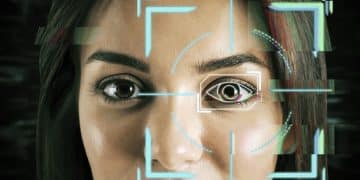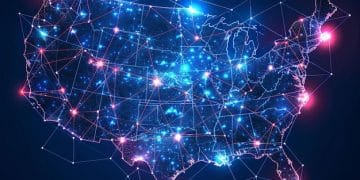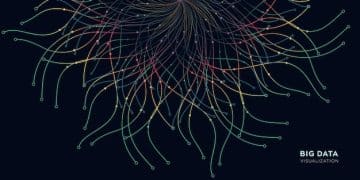The Ethics of Facial Recognition Technology: A US Perspective
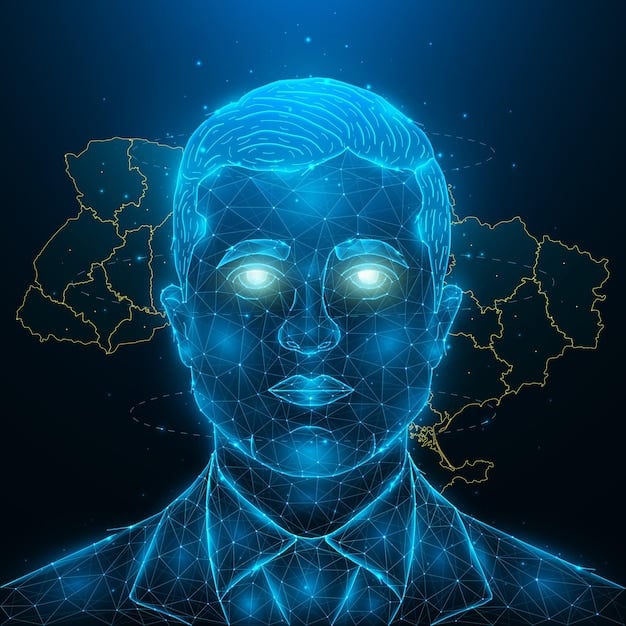
The Ethics of Facial Recognition Technology: Balancing Security and Privacy in the US is a complex issue involving civil liberties, security needs, and technological advancements within the United States.
Facial recognition technology has rapidly advanced, becoming increasingly prevalent in various aspects of daily life. However, this technology raises significant ethical concerns, particularly regarding the balance between security and individual privacy in the US. Understanding the ethics of facial recognition technology: balancing security and privacy in the US is crucial for navigating this complex landscape.
The widespread use of facial recognition by law enforcement, businesses, and government agencies raises questions about potential misuse, bias, and infringement on civil liberties. Exploring these issues allows us to promote responsible implementation of this technology. In this article, we delve into the key ethical considerations surrounding the implementation of facial recognition in the United States.
The Rise of Facial Recognition Technology in the US
Facial recognition technology has seen exponential growth in recent years, driven by advancements in artificial intelligence and machine learning. This technology is now used in a wide range of applications, from unlocking smartphones to enhancing security measures at airports and public spaces.
In the US, the adoption of facial recognition technology has been particularly rapid, driven by both public and private sector interests. Law enforcement agencies use it to identify suspects, businesses employ it for customer authentication, and government agencies leverage it for various security purposes. However, the increasing prevalence of this technology has raised significant concerns about its potential impact on privacy and civil liberties.
Key Applications of Facial Recognition
Facial recognition technology is being applied across various sectors in the United States. Here’s an overview of some key applications:
- Law Enforcement: Used for identifying suspects, tracking individuals, and enhancing surveillance capabilities.
- Security: Employed in airports, stadiums, and other public spaces to enhance security and detect potential threats.
- Commercial Use: Utilized for customer authentication, targeted advertising, and personalized experiences in retail and service industries.
- Access Control: Implemented for secure access to buildings, devices, and sensitive information.
These applications highlight the broad scope of facial recognition technology and underscore the need for a comprehensive ethical framework to guide its use.
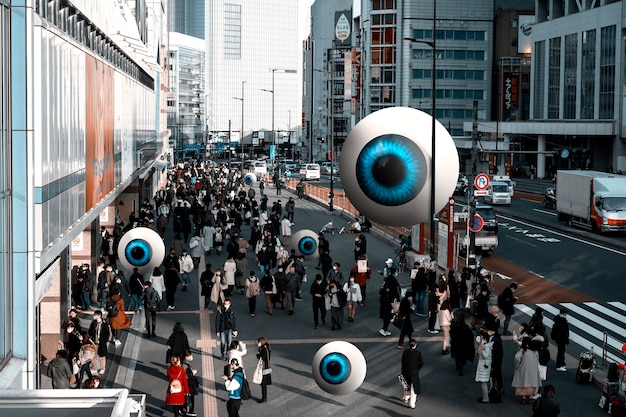
As facial recognition technology becomes more integrated into our daily lives, the ethical implications demand careful consideration. Finding the right balance between security and individual rights is essential to ensure that this technology is used responsibly and ethically. The ethics of facial recognition technology: balancing security and privacy in the US requires ongoing dialogue and the development of clear guidelines and regulations.
Privacy Concerns and Civil Liberties
The widespread deployment of facial recognition technology raises significant privacy concerns. With the ability to identify and track individuals in real-time, there is a risk of mass surveillance and the erosion of personal privacy.
Civil liberties advocates argue that the use of facial recognition technology by law enforcement, without proper oversight and regulation, can lead to discriminatory practices and the infringement of constitutional rights. Concerns have been raised about the potential for misuse of this technology to target marginalized communities and suppress dissent.
Potential for Mass Surveillance
The ability to identify and track individuals through facial recognition technology raises alarms about the potential for mass surveillance. Here are some critical aspects of this concern:
- Constant Monitoring: Facial recognition can enable continuous monitoring of individuals in public spaces, eroding the sense of privacy and anonymity.
- Data Collection: The data collected through facial recognition can be stored and analyzed, creating detailed profiles of individuals and their activities.
- Chilling Effect: The knowledge that one is being constantly monitored can have a chilling effect on free speech and assembly.
These points underscore the need for robust safeguards to protect against the potential for mass surveillance and ensure that facial recognition technology is used in a manner that respects individual rights.
The ethics of facial recognition technology: balancing security and privacy in the US requires a careful evaluation of the trade-offs between security and civil liberties. It is essential to establish clear legal and ethical boundaries to prevent the misuse of this technology and protect the fundamental rights of individuals.

Bias and Discrimination in Facial Recognition
One of the most pressing ethical concerns surrounding facial recognition technology is its potential for bias and discrimination. Studies have shown that facial recognition algorithms often exhibit significant disparities in accuracy across different demographic groups.
These biases can lead to discriminatory outcomes, particularly in law enforcement and security applications. For example, if a facial recognition system is less accurate in identifying individuals from certain racial or ethnic groups, it could result in wrongful arrests or disproportionate targeting of those communities.
Impact on Marginalized Communities
The biases inherent in facial recognition technology can have a disproportionate impact on marginalized communities. Here are some key aspects to consider:
- Accuracy Disparities: Facial recognition systems often perform less accurately on individuals with darker skin tones, leading to higher rates of misidentification.
- Discriminatory Targeting: Biased algorithms can result in the discriminatory targeting of specific groups, perpetuating existing inequalities.
- Erosion of Trust: The use of biased facial recognition technology can erode trust between law enforcement and the communities they serve.
Addressing these concerns requires a commitment to developing and deploying facial recognition systems that are fair, accurate, and free from bias.
The ethics of facial recognition technology: balancing security and privacy in the US necessitates ongoing efforts to identify and mitigate bias in algorithms. Regular testing and evaluation, as well as transparency in data sets and methodologies, are essential to ensure that facial recognition technology does not perpetuate discrimination.
Legal and Regulatory Frameworks
The legal and regulatory frameworks governing the use of facial recognition technology in the US are still evolving. Currently, there is no comprehensive federal law that specifically addresses facial recognition, leading to a patchwork of state and local regulations. The absence of a unified legal framework creates uncertainty and allows for inconsistent practices across different jurisdictions.
Several states and cities have enacted laws and policies to regulate the use of facial recognition technology, particularly by law enforcement. These regulations often include provisions related to transparency, accountability, and oversight.
Key Legislation and Policies
Here are some examples of legislation and policies that have been implemented to regulate facial recognition technology:
- Illinois Biometric Information Privacy Act (BIPA): One of the most comprehensive state laws, BIPA regulates the collection, use, and storage of biometric data, including facial recognition data.
- San Francisco Ban on Facial Recognition: San Francisco was one of the first cities to ban the use of facial recognition technology by local government agencies.
- EU General Data Protection Regulation (GDPR): While not specific to the US, the GDPR has influenced the debate around data privacy and has prompted discussions about similar regulations in the US.
These examples highlight the growing recognition of the need for clear legal and regulatory frameworks to govern the use of facial recognition technology.
The ethics of facial recognition technology: balancing security and privacy in the US demands a robust legal framework that protects individual rights while allowing for responsible innovation. A comprehensive federal law could provide consistent standards and safeguards to ensure that facial recognition technology is used ethically and in accordance with constitutional principles.
The Role of Transparency and Accountability
Transparency and accountability are essential components of an ethical framework for facial recognition technology. Transparency ensures that the public is informed about how facial recognition technology is being used, while accountability provides mechanisms for addressing potential harms and abuses.
Government agencies and private companies should be transparent about their use of facial recognition technology, including the type of data collected, the purpose for which it is used, and the safeguards in place to protect privacy and prevent misuse. Independent oversight bodies can play a critical role in ensuring that facial recognition systems are used responsibly and ethically.
Best Practices for Ethical Implementation
Implementing facial recognition technology ethically requires adherence to best practices that prioritize transparency and accountability. Here are some key considerations:
- Public Disclosure: Clearly communicate how facial recognition technology is being used and its potential impact on individuals.
- Data Security: Implement robust security measures to protect against unauthorized access and misuse of facial recognition data.
- Independent Audits: Conduct regular audits by independent experts to assess the accuracy, fairness, and effectiveness of facial recognition systems.
By adopting these practices, organizations can demonstrate a commitment to using facial recognition technology in a manner that respects individual rights and fosters public trust.
The ethics of facial recognition technology: balancing security and privacy in the US relies heavily on transparency and accountability. Without these elements, there is a risk that facial recognition technology will be used in ways that undermine privacy, civil liberties, and democratic values. Promoting transparency and accountability is essential to ensure that facial recognition technology serves the public good.
| Key Aspect | Brief Description |
|---|---|
| ⚖️ Privacy Concerns | Risk of mass surveillance and erosion of personal privacy in the US. |
| 🤖 Algorithmic Bias | Potential for discrimination due to accuracy disparities in facial recognition on different demographics. |
| 📜 Legal Frameworks | Evolving state and local regulations; lack of comprehensive federal law for facial recognition. |
| 👁️ Transparency | Importance of public disclosure and independent audits. |
Frequently Asked Questions
The main ethical concerns revolve around privacy violations, potential for bias and discrimination, and the lack of comprehensive legal frameworks governing its use. The ethics of facial recognition technology: balancing security and privacy in the US remains a key challenge.
Algorithmic bias can be addressed through diverse data sets, regular testing and validation, and transparency in the development and deployment of facial recognition systems. Continuous monitoring and improvement is essential too.
Legal and regulatory frameworks provide clear guidelines and standards for the use of facial recognition technology. These frameworks help protect individual rights and ensure that the technology is used responsibly and ethically, focusing on the ethics of facial recognition technology: balancing security and privacy in the US.
Transparency ensures that the public is informed about how facial recognition is being used, its potential impact, and the safeguards in place. It fosters public trust and allows for informed participation in decisions about its use.
Benefits include enhanced security in public spaces, improved customer authentication, and more efficient access control. Implementing privacy-enhancing techniques and adhering to ethical guidelines are crucial for the ethics of facial recognition technology: balancing security and privacy in the US.
Conclusion
In conclusion, the ethical considerations surrounding facial recognition technology are complex and multifaceted. Addressing these concerns requires a comprehensive approach that encompasses legal frameworks, ethical guidelines, transparency, and accountability. The implementation of facial recognition technology must prioritize individual rights, fairness, and democratic values.
Ultimately, navigating the ethics of facial recognition technology: balancing security and privacy in the US is essential to ensure that this technology is used in a manner that benefits society while protecting fundamental freedoms. Ongoing dialogue and collaboration among stakeholders are crucial to achieving this balance.

